IASbaba's Daily Current Affairs Analysis
Archives
(PRELIMS & MAINS Focus)
Syllabus
- Prelims – History and Art and Culture
Context: Recently the Shaheedi Divas of Guru Tegh Bahadur, the ninth guru of the Sikhs was commemorated.
About Guru Tegh Bahadur:
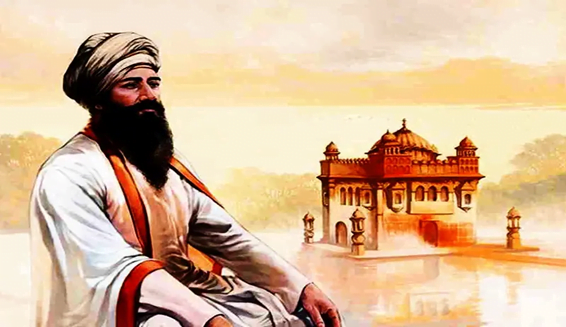
- Tegh Bahadur was born in Amritsar on April 21, 1621 to Mata Nanki and Guru Hargobind, the sixth Sikh guru, who raised an army against the Mughals and introduced the concept of warrior saints.
- After Guru Ram Das, the fourth Sikh guru, the guruship became hereditary.
- Aurangzeb was the ruling Mughal emperor at the time Guru Tegh Bahadur’s guruship.
- His sermons, delivered in a mix of Sadukhri and Braj languages.
- While the guru was on the way back from Dhaka, Raja Ram Singh sought his help to broker a truce with the Ahom king.
- Gurdwara Dhubri Sahib on the banks of the Brahmaputra commemorates this peace accord.
- The guru was also honoured at Guwahati’s Kamakhya temple.
- The Guru himself went to Delhi where he revealed his identity, and was arrested by the Mughals.
- Aurangzeb ordered the public execution of the Guru on November 11, 1675 after the guru declined to embrace Islam.
- Gurdwara Sis Ganj was built on the site on which they were executed.
Source: Indian Express
Previous Year Question
Q.1) With reference to Indian history, who of the following were known as “Kulah-Daran” ? (2022)
- Arab merchants
- Qalandars
- Persian calligraphists
- Sayyids
Syllabus
- Prelims – History and Art and Culture
Context: The birth anniversary of Tippu Sultan was observed recently, bringing his contested legacy to the forefront of political discourse once again.
About Tippu Sultan:
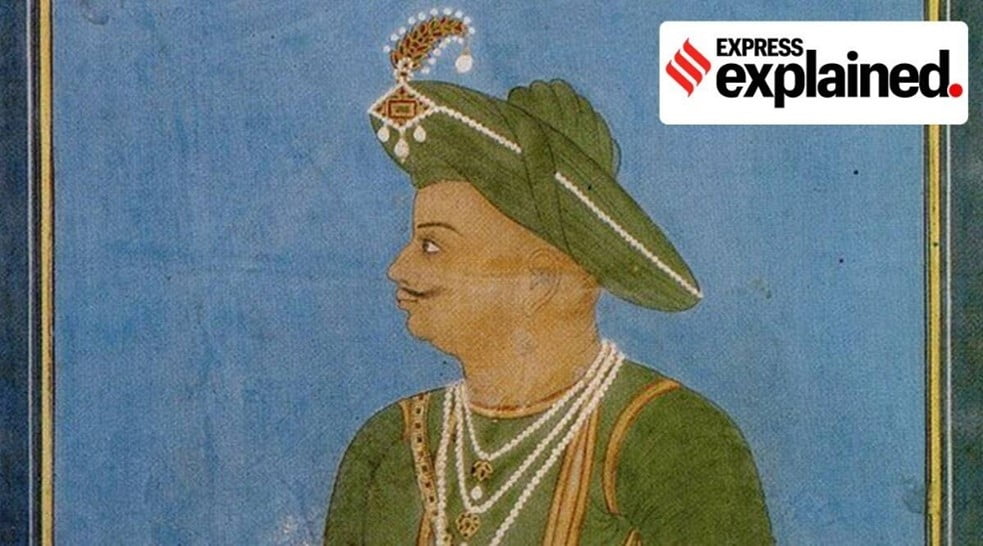
- Tippu Sultan was born Sultan Fateh Ali Sahab Tippu on November 10, 1750 in Devanahalli, present-day Bangalore.
- He was born to Hyder Ali, who rose through the ranks of the army of the Wodeyars, the then Hindu rulers of Mysore.
- Tipu Sultan was also known as the Tiger of Mysore.
- He expanded the iron-cased Mysorean rockets and commissioned the military manual Fathul Mujahidin.
- He deployed the rockets against advances of British forces and their allies during the Anglo-Mysore Wars, including the Battle of Pollilur and Siege of Srirangapatna.
- He negotiated the 1784 Treaty of Mangalore with the British, ending the Second Anglo-Mysore War.
- Tipu’s conflicts with his neighbours included the Maratha–Mysore War, which ended with the signing of the Treaty of Gajendragad.
- In the Third Anglo-Mysore War, he was forced into the Treaty of Seringapatam, losing a number of previously conquered territories.
- In the Fourth Anglo-Mysore War, a combined force of British East India Company troops, supported by the Marathas and the Nizam of Hyderabad defeated Tipu in 1799.
Contributions and conflicts associated with Tippu Sultan:
- He made regular endowments during this period to many Hindu temples, including the famed Ranganathaswami Temple at Srirangapatna.
- Many sources mention the appointment of Hindu officers in Tipu’s administration] and his land grants and endowments to Hindu temples, which are cited as evidence for his religious tolerance.
- Among the punishments Tipu applied to rebels or conspirators were forced conversion and the transfer of people from their home territories to Mysore.
- His religious legacy has become a source of controversy in India, with some groups proclaiming him a great warrior for the faith or Ghazi for both religious and political reasons.
- Various sources describe the massacres, imprisonment and forced conversion of Hindus (Kodavas of Coorg, Nair’s of Malabar) and Christians (Catholics of Mangalore), the destruction of churches and temples, and the clamping down on Muslims (Mappila of Kerala, the Mahdavia Muslims, the rulers of Savanur and the people of Hyderabad State), which are sometimes cited as evidence for his intolerance.
Reforms Introduced:
- Tippu is credited for the introduction of iron-cased rockets in warfare.
- Tippu Sultan introduced first modern war rockets in the Anglo Mysore Wars (though some sources say that it was his father Hyder Ali who introduced these and Tipu only improved upon existing models).
- Tipu Sultan also pioneered administrative and economic reforms.
- coinage system:
- Haidar Ali added pagodas on coins with Persian legends, always in the name of the Mughal emperor Shah Alam II.
- His successor, Tipu Sultan, continued to issue pagodas, mohurs and rupees, with legends that were completely new.
- As for copper, the new large paisa was commenced by Haidar Ali and was continued throughout the reign of Tipu Sultan, who added other denominations.
- He started a new land revenue system in Mysore, as well as introduced sericulture, which continues to employ many Kannadigas to date.
Source: Indian Express
Previous Year Questions
Q.1) Which one of the following statements does not apply to the system of Subsidiary Alliance introduced by Lord Wellesley? (2018)
- To maintain a large standing army at others expense
- To keep India safe from Napoleonic danger
- To secure a fixed income for the Company
- To establish British paramountcy over the Indian States
Syllabus
- Prelims – Environment and Ecology
Context: Recently Karnataka’s principal chief conservator of forest (wildlife) has requested the National Tiger Conservation Authority (Project Tiger Division) to include the Kali Tiger Reserve in the phase III of the economic valuation of tiger reserves in India.
About Kali Tiger Reserve:
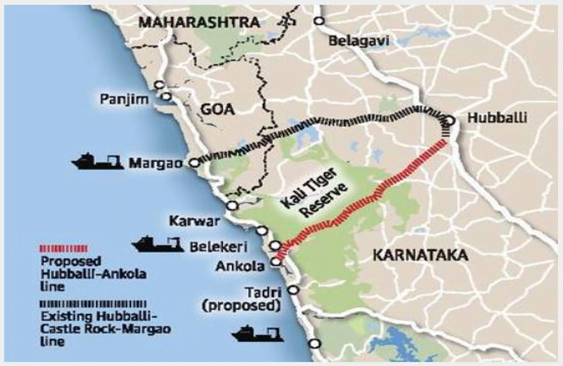
- Kali Tiger Reserve is located in Uttara Kannada District of Karnataka State. Covering the taluks of Haliyal, Karwar and Joida, the Kali Tiger Reserve (KTR) is part of the Uttara Kannada district of Karnataka.
- The Tiger Reserve comprises of two important protected areas of the region viz., Dandeli Wildlife Sanctuary and Anshi National Park.
- Dandeli Wildlife Sanctuary (475.018 sq. km) and Anshi National Park (339.866 sq km) are contiguous to each other and form a single tract of protected area located in biologically sensitive Western Ghats.
- The park is a habitat of Bengal tigers, black panthers and Indian elephants.
- Kali Tiger Reserve (KTR) in Karnataka is located in the biologically sensitive Western Ghats and a UNESCO world heritage site and a global biodiversity hotspot.
- The Kali River flows through the tiger reserve hence the name Kali Tiger Reserve.
- The park is in the ecoregions of North Western Ghats montane rain forests and North Western Ghats moist deciduous forests, both of which are deemed endangered by the World Wide Fund for Nature (WWF).
- Other large mammals here include: Indian bison, sloth bear, Indian wild boar, bonnet macaque, northern plains grey langur, grey slender loris, barking deer (muntjac), mouse deer (chevrotain), sambar deer and spotted deer (chital or axis deer).
MUST READ: National Tiger Conservation Authority and TR’s in India
Source: The Hindu
Previous Year Questions
Q.1) Among the following Tiger Reserves, which one has the largest area under “Critical Tiger Habitat”? (2020)
- Corbett
- Ranthambore
- Nagarjunsagar-Srisailam
- Sundarbans
Q.2) The term M-STrIPES’ is sometimes seen in news in the context of (2017)
- Captive breeding of Wild Fauna
- Maintenance of Tiger Reservoirs
- Indigenous Satellite Navigation System
- Security of National Highways
Q.3) Consider the following statements :
- Animal Welfare Board of India is established under the Environments (Protection) Act, 1986
- National Tiger Conservation Authority is a statutory body
- National Ganga River Basin Authority is chaired by the Prime Minister
Which if the statements given above is/are correct? (2014)
- 1 only
- 2 and 3 only
- 2 only
- 1, 2 and 3
Syllabus
- Prelims – Miscellaneous Current Affairs
Context: The mascots of Paris 2024 Olympic and Paralympic Games are designed like the red Phrygian cap and are called Les Phryges.
About Les Phryges:

- The Phryges are the official mascots of Paris 2024 Olympic and Paralympic Games.
- They are two little female anthropomorphic Phrygian caps that are a strong symbol of France.
- The Phrygian cap, a soft, generally red hat, was worn by freed slaves in Phrygia, an ancient Greek kingdom in what is now Turkey.
- The Phrygian cap originated in the ancient country of Phrygia (in modern Turkey.
- The French Revolution was also the time that the earliest representations of a woman wearing a Phrygian cap — the allegorical Marianne — made an appearance in art.
- It is also an international symbol of liberty present in many emblems in North and South America.
Source: Indian Express
Syllabus
- Prelims – Environment
In news: CCPI 2023 was released in COP 27, assessing 59 countries and the European Union on climate change policies and actions.
About CCPI:
- Published annually since 2005, the Climate Change Performance Index (CCPI) is an independent monitoring tool for tracking the climate protection performance of 59 countries and the EU.
- These 59 countries together account for 92% of global greenhouse gas emissions.
- Published by German Watch, New Climate Institute and Climate Action Network International based in Germany.
- The CCPI aims to enhance transparency in international climate politics and enables comparison of climate protection efforts and progress made by individual countries.
- The climate protection performance is assessed in four categories:
- GHG Emissions (40% of overall score),
- Renewable Energy (20% of overall score),
- Energy Use (20% of overall score) and
- Climate Policy (20% of overall score).
India’s performance:
- India jumps 2 spots higher, and now ranks 8th.
- India has been ranked amongst top 5 countries in the world, and the best among the G20 countries, based on its Climate Change performance.
- CCPI places India as the only G-20 country in the top 10 rank.
- Denmark, Sweden, Chile and Morocco as the only four small countries that were ranked above India as 4th, 5th, 6th and 7th respectively.
- The first, second and third ranks were not awarded to any country.
- In effect therefore, India’s rank is the best amongst all large economies.
- India earned a high rating in the GHG Emissions and Energy Use categories, while a medium for Climate Policy and Renewable Energy.
- As per the CCPI report, India is on track to meet its 2030 emissions targets (compatible with a well-below-2°C scenario).
- Various demand side flagship programs such as UJALA, PAT Scheme and Standards and Labelling Programme that have contributed significantly to this notable achievement.
Source: PIB
Syllabus
- Prelims – Current Affairs
In news: Delhi Police approached a court to conduct a polygraph test on Aaftab Poonawala, suspected of killing his partner Shraddha Walkar, to help investigators find the missing weapon and other evidence in the murder case.
About polygraph test:
- A polygraph test is a lie detector test.
- It assumes that physiological responses (heartbeat, changes in breathing, sweating, etc.) triggered when a person is lying are different from what they would be otherwise.
- Instruments like cardio-cuffs or sensitive electrodes are attached to the person, and variables such as blood pressure, pulse, blood flow, etc., are measured as questions are put to them.
- A numerical value is assigned to each response to conclude whether the person is telling the truth, is deceiving, or is uncertain.
- First done in the 19th century by the Italian criminologist Cesare Lombroso, who used a machine to measure changes in the blood pressure of criminal suspects during interrogation.
- Neither polygraph tests nor narco tests have been proven scientifically to have a 100% success rate, and remain contentious in the medical field as well.
- The results of the tests cannot be considered “confessions”.
- However, any information or material subsequently discovered with the help of such a voluntarily-taken test can be admitted as evidence, the Supreme Court said, in ‘Selvi & Ors vs State of Karnataka & Anr’ (2010).
- No lie detector tests should be administered except based on consent of the accused.
- The consent should be recorded before a judicial magistrate.
- Those who volunteer must have access to a lawyer, and have the physical, emotional, and legal implications of the test explained to them by police and the lawyer.
- the ‘Guidelines for the Administration of Polygraph Test on an Accused’ published by the National Human Rights Commission in 2000, must be strictly followed.
- The Supreme Court took into consideration international norms on human rights, the right to a fair trial, and the right against self-incrimination under Article 20(3) of the Constitution, as it is feared that a false confession could be obtained at times when a case needs to be solved quickly.
- A forcible intrusion into a person’s mental processes is an affront to human dignity and liberty, often with grave and long-lasting consequences.
Source: Indian Express
Syllabus
- Prelims – Economy
In News: Banks wrote off more than Rs 10 lakh crore in loans over the last five years, according to RBI under the Right to Information (RTI) Act.
- They have been able to recover only 13% of the $123.86 billion they wrote off.
- Public sector banks write-offs accounted for 72.78% includes SBI, PNB and BOB.
- Private sector banks accounted for 27.2% includes ICICI (highest reduction), Axis Bank, HDFC Bank.
About Loan Write Offs:
- A loan is an asset on the balance sheet of a bank, lent out of depositor’s money.
- Writing off a loan essentially means it will no longer be counted as an asset.
- The bank writes off a loan after the borrower has defaulted on the loan repayment and there is a very low chance of recovery.
- The lender then moves the defaulted loan, or NPA, out of the assets side and reports the amount as a loss.
- After the write-off, banks are supposed to continue their efforts to recover the loan using various options and make provisioning as well.
- Significance:
- By writing off loans, a bank can reduce the level of non-performing assets (NPAs) on its books.
- Amount so written off reduces the bank’s tax liability.
- Due to low chances of recovery from written-off loans, it raises questions about the assets or collateral against which the banks lent funds to these defaulters.
MUST READ NPAs
Source: Indian Express
Previous Year Question
Q1.) What is the importance of the term “Interest Coverage Ratio” of a firm in India?(2020)
- It helps in understanding the present risk of a firm that a bank is going to give loan to.
- It helps in evaluating the emerging risk of a firm that a bank is going to give loan to.
- The higher a borrowing firm’s level of Interest Coverage Ratio, the worse is its ability to service its debt.
Select the correct answer using the code given below:
- 1 and 2 only
- 2 only
- 1 and 3 only
- 1, 2 and 3
Syllabus
- Prelims – Economy
In News: RBI’s data on State-wise C-D ratio of scheduled commercial banks according to place of utilisation was released.
- Ratio of the Northern and Western Regions declined in 2022 even as that of the North-Eastern, Eastern, Central and Southern Regions improved.
- States that saw improvement are: Haryana, Himachal Pradesh, and Rajasthan
- States that saw a decline are: Punjab, Chandigarh, and Delhi
About CD ratio:
- Credit-Deposit Ratio = Total Advances/Total Deposits *100
- It is the ratio of how much a bank lends out of deposits it has mobilised.
- It indicates how much of each rupee of deposit goes towards credit markets in a particular region.
- For example, a CD ratio of 75% means that three-fourth of deposits of banks has been given out as loans.
- A very low ratio indicates banks are not making full use of their resources (i.e. deposits), shows poor credit growth.
- Alternatively, a high ratio indicates more reliance on deposits for lending purposes and may be risky.
- It may become difficult to cover any unforeseen fund requirements, may affect capital adequacy and asset-liability mismatch.
- CD ratio helps in assessing a bank’s liquidity and indicates its health.
- RBI does not stimulate a minimum or maximum level for the ratio.
- It is used as a broad indicator for measuring the inter-State disparities in banking development and the role of banking in economic activity.
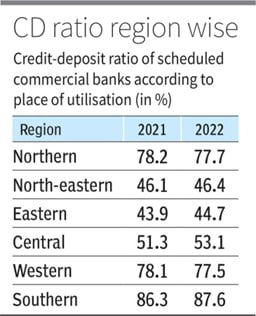
Source The Hindu BusinessLine
Previous Year Question
Q.1) Despite being a high saving economy, capital formation may not result in significant increase in output due to (2018)
- weak administrative machinery
- illiteracy
- high population density
- high capital-output ratio
Q.2) A decrease in tax to GDP ratio of a country indicates which of the following? (2015)
- Slowing economic growth rate
- Less equitable distribution of national income
Select the correct answer using the code given below.
- 1 only
- 2 only
- Both 1 and 2
- Neither1 nor 2
Syllabus
- Mains – GS 2 (Governance)
Context: Recently the Ministry of Environment, Forest and Climate Change gave environmental clearance for the ambitious Rs 72,000 crore development project on the strategically important Great Nicobar Island. The project is to be implemented in three phases over the next 30 years.
About the Great Nicobar Island:
- Great Nicobar, the southernmost of the Andaman and Nicobar Islands, has an area of 910 sq km.
- The Andaman and Nicobar Islands are a cluster of about 836 islands in the eastern Bay of Bengal, the two groups of which are separated by the 150-km wide Ten Degree Channel.
- The Andaman Islands lie to the north of the channel, and the Nicobar Islands to the south.
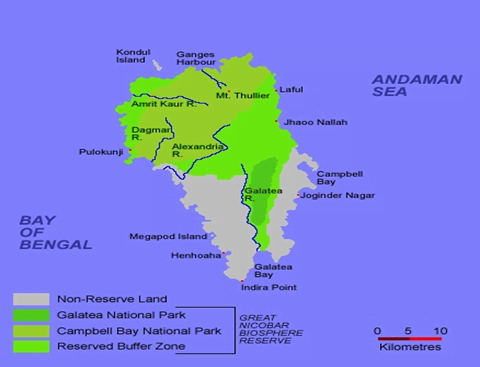
- Indira Point on the southern tip of Great Nicobar Island is India’s southernmost point, less than 150 km from the northernmost island of the Indonesian archipelago.
- Great Nicobar is home to two national parks, a biosphere reserve, and the Shompen and Nicobarese tribal peoples, along with ex-servicemen from Punjab, Maharashtra, and Andhra Pradesh who were settled on the island in the 1970s.
- The Shompen are hunter-gatherers who depend on forest and marine resources for sustenance.
- An estimated 237 Shompen and 1,094 Nicobarese individuals now live in a 751 sq km tribal reserve, some 84 sq km of which is proposed to be denotified. The approximately 8,000 settlers who live on the island are engaged in agriculture, horticulture, and fishing.
- The Great Nicobar Island has tropical wet evergreen forests, mountain ranges reaching almost 650 m above sea level, and coastal plains.
- Fourteen species of mammals, 71 species of birds, 26 species of reptiles, 10 species of amphibians, and 113 species of fish are found on the island, some of which are endangered. The leatherback sea turtle is the island’s flagship species.
About proposed projects:
- A “greenfield city” has been proposed, including an International Container Transhipment Terminal (ICTT), a greenfield international airport, a power plant, and a township for the personnel who will implement the project.
- As per NITI Ayog, “The proposed port will allow Great Nicobar to participate in the regional and global maritime economy by becoming a major player in cargo transhipment,’’
- The port will be controlled by the Indian Navy, while the airport will have dual military-civilian functions and will cater to tourism as well.
- Roads, public transport, water supply and waste management facilities, and several hotels have been planned to cater to tourists.
- A total 166.1 sq km along the southeaster and southern coasts of the island have been identified for project along a coastal strip of width between 2 km and 4 km.
- Some 130 sq km of forests have been sanctioned for diversion, and 9.64 lakh trees are likely to be felled.
- Development activities are proposed to commence in the current financial year, and the port is expected to be commissioned by 2027–28.
- More than 1 lakh new direct jobs and 1.5 lakh indirect jobs are likely to be created on the island over the period of development
Benefits of the Projects:
- The island has a lot of tourism potential, but the government’s greater goal is to leverage the locational advantage of the island for economic and strategic reasons.
- Great Nicobar is equidistant from Colombo to the southwest and Port Klang and Singapore to the southeast, and positioned close to the East-West international shipping corridor, through which a very large part of the world’s shipping trade passes.
- The proposed ICTT can potentially become a hub for cargo ships travelling on this route.
- The proposal to develop Great Nicobar was first floated in the 1970s, and its importance for national security and consolidation of the Indian Ocean Region has been repeatedly underlined.
- Increasing Chinese assertion in the Bay of Bengal and the Indo-Pacific has added great urgency to this imperative in recent years.
Environmental and other concerns:
- The proposed massive infrastructure development in an ecologically important and fragile region, including the felling of almost a million trees, has alarmed many environmentalists.
- The loss of tree cover will not only affect the flora and fauna on the island, it will also lead to increased runoff and sediment deposits in the ocean, impacting the coral reefs in the area, they have cautioned.
- Coral reefs, already under threat from warming oceans, are of enormous ecological importance.
- Environmentalists have also flagged the loss of mangroves on the island as a result of the development project.
- India has successfully translocated a coral reef from the Gulf of Mannar to the Gulf of Kutch earlier.
Government’s stand on the projects:
- According to the government, expediting the project is of paramount national security and strategic importance.
- The project site is outside the eco-sensitive zones of Campbell Bay and Galathea National Park.
- The Centre has said that the development area is only a small percentage of the area of the island and its forest cover, and that 15 per cent of the development area itself will be green cover and open spaces.
- The Zoological Survey of India is currently in the process of assessing how much of the reef will have to be relocated for the project.
- The government has said that a conservation plan for the leatherback turtle is also being put in place.
Thus, the developmental of project is necessary while recognising its significance of national security, strategic location along with socio-economic importance, however the project need to be carried out after proper Social-economic assessment and its impact. The culture , traditional and practices of local tribal communities should not be compromised at the cost of development then only this development will be a sustainable development.
Source: Indian Express
Previous Year Questions
Q.1) “Biorock technology” is talked about in which one of the following situations? (2022)
- Restoration of damaged coral reefs
- Development of building materials using plant residues
- Identification of areas for exploration/extraction of shale gas
- Providing salt licks for wild animals in forests/protected areas
Syllabus
- Mains – GS 2 (Governance) and GS 3 (Environment and Disaster Management)
Context: If India has to achieve the set of goals enunciated in the ‘Panchamrit’ resolution of the COP26 climate summit in Glasgow 2021, it is necessary that panchayati raj institutions, the third tier of government which are closest to the people, are involved.
India’s climate action commitments:
The latest updated Nationally Determined Contribution (NDC) of India is a step towards India’s goal to reach net-zero emissions (NZE) by 2070. Indian Prime Minister at UNFCCC CoP-26 (Glasgow, 2021) announced its enhanced climate commitments — the “Panchamrit” :
- strengthening emissions intensity of its GDP by 45% by 2030 from its 2005 levels
- 50% of cumulative electric power installed capacity from non-fossil fuel-based energy resources by 2030.
- Reduce 1 billion carbon emissions by 2030
- Produce 500GW non-fossil fuel energy capacity by 2030
- Achieving NZE by 2070
Role of panchayat Raj System in climate action:
- Although international and national policies have been formulated with large-scale investments, it is necessary to have a suitable local action plan for implementation and enforcement, initiated and coordinated by local governments.
- In the context of greater devolution that has taken place, panchayats, as local governments, can play a pivotal role in tackling many of the causes and effects of climate change.
- Over the past few decades, there has been a manyfold increase in the number of climate-related national disasters. Much of India’s population still lives in the rural areas and is involved in agriculture and other Agri-based activities.
- The greater variability in rainfall and temperatures, etc. experienced of late has directly affected the livelihood and well-being of millions of rural households.
- India’s National Action Plan on Climate Change (NAPCC) 2008 identifies a range of priority areas for coordinated intervention at the national and State levels.
- However, there would have been better results had panchayati raj institutions been given a greater role.
- Through the ongoing decentralisation process which ensures people’s participation, panchayats can play a crucial and frontline role in coordinating effective responses to climate risks, enabling adaptation and building climate-change resilient communities.
Case study 1: The Meenangadi movement in Kerala
In recent years, many panchayats have come forward with the concept of carbon neutrality, a prominent example being Meenangadi gram panchayat in Kerala’s Wayanad district. In 2016, the panchayat envisaged a project called ‘Carbon neutral Meenangadi’ with following activities:
- There were campaigns, classes and studies to begin with. An awareness programme was conducted initially.
- A greenhouse gases emission inventory was prepared. The panchayat was found to be carbon positive.
- An action plan was prepared by organising gram sabha meetings.
- Socio-economic surveys and energy-use mapping were carried out.
- Several multi sector schemes were implemented to reduce emissions, increase carbon sequestration, and preserve the ecology and bio-diversity.
- ‘Tree banking’ was one of landmark schemes introduced to aid carbon neutral activities which encouraged the planting of more trees by extending interest-free loans.
- The planted trees were geo-tagged to monitor their growth.
- The entire community was involved in the process, with school students, youth, and technical and academic institutions given different assignments.
- Local economic development was another thrust area where LED bulb manufacturing and related micro-enterprises were initiated.
Case study 2: Palli gram panchayat in Jammu and Kashmir
The Palli gram panchayat in Jammu and Kashmir that has followed the same people-centric model, with specific local activities. The panchayat has prepared a climate-resilient plan where villagers have been made aware of climate change Mitigation factors such as:
- reducing energy consumption
- cutting down on the use of fossil fuels
- use of solar energy
- abandoning plastics
- promoting plantation and water conservation measures
- Bio-gas plants
- A solar plant (500KW) has been installed to power households. A
- Gram Panchayat Development Plan (GPDP) for 2022-23 is being prepared by integrating a climate-resilient plan.
The other examples include:
- In Seechewal gram panchayat, the Kali Bein River was rejuvenated with people’s involvement.
- Odanthurai panchayat in Tamil Nadu has its own windmill
- Tikekarwadi gram panchayat in Maharashtra is well known for its extensive use of biogas plants and green energy production.
- Chapparapadavu gram panchayat in Kerala has several green islands that have been nurtured by the community.
Suggestive measures for the local governance system:
The Ministry of Panchayati Raj has focused its attention on localising the Sustainable Development Goals (SDGs) on a thematic basis. ‘Clean and Green Village’ has been identified as the fifth theme where panchayats can take up activities on:
- natural resource management
- biodiversity protection
- waste management
- afforestation activities.
According to the latest data, 1,09,135 gram panchayats have prioritised ‘Clean & Green Village’ as one of their focus areas for 2022-23.The Ministry has highlighted the need for the documentation of best practices and for wider dissemination.
The net result is that many panchayats are coming forward with their eco plans. The integrated Panchayat Development Plan prepared by all panchayats is a stepping stone towards addressing many of the environmental concerns of villages.
Therefore, in this modern age of rapid technological advancements and digital transformation, India’s rural local bodies are silently contributing their strength to ensuring the global target of carbon neutrality, as envisaged in the UN conference on climate change.
Source: The Hindu
Syllabus
- Mains – GS 1 Women Empowerment, GS 3 Economy
Context:
- As the world hits a population milestone of 8 billion, India is all set to become the world’s most populous country in 2023, much before 2027, as predicted earlier by the United Nations Population Division.
- India is poised to gain a massive number of working-age individuals in the next 25 years, almost every fifth in the world.
- Such a huge potential of human resources will not benefit Indian economy, unless we are able to enhance women’s participation on a significant scale.
Challenges for females:
- Low Female labour force participation rate (FLFPR)
- India was placed at 140 of 156 countries in 2021 by The Global Gender Gap Report of the World Economic Forum.
- Further, it remains in declining mode, having fallen from 30.5% in 2000 to 21.1% in 2019, and 18.6% in 2020, by International Labour Organisation figures;
- It hit a record low of 15.5% during the first covid lockdown when many urban women either quit or lost their jobs
- Non-diverse growth: A 2020 research study observed that a structural shift and sectoral transformation in the Indian economy (1983-2018) made no impact on the pattern of women’s employment in India, both quantitatively and qualitatively.
- In terms of absolute numbers, it decreased from 148.6 million in 2004-05 to 104.1 million in 2017-18.
- Overdependence on agriculture: With little space for job diversification, women continued to overcrowd the agriculture sector, despite its declining share of the economy. Non-farm sectors did not open many opportunities for them.
- Workplace Discrimination: 90% of working women are in the informal sector and hence, they are subject to high degrees of gender discrimination in wages, job and social security.
- Oxfam India’s India Discrimination Report 2022 – wages are lower for women overwhelmingly because of discriminatory practices and only slightly due to lack of education and work experience.
- In 2019-20, about 60% of men (aged 15 years and above) had either regular salaried and self-employed jobs, while only 20% for women.
- Social hurdles: A significant number of qualified women were found unwilling to join the labour market due to ‘family responsibilities’.
- The Economic Survey of 2020, 60% of women in the 15-59-years age group are engaged in full-time housework, as compared to 1% of men.
- 84% of Indians agree to the view that in a situation of job scarcity, “men have more right to opportunities than women”.
- Low GDP Contribution: Bloomberg Economics analysis estimated that though Indian women represent 48% of India’s population, they contribute only around 17% of GDP, compared to 40% in China.
- Other factors: Several cross-cutting factors like a disproportionate burden of child care, an income effect, logistical barriers of mobility and safety, and socio-cultural norms around marriage, etc, have also acted as deterrents to Indian women entering our labour market.
- A 2019 UNDP study – India has so far seen only a downward trend in women’s workforce participation as their education has risen, and that combined participation (labour market and/or educational) covered only 55-60% of young working age women.
Suggestions for future:
- India’s trend of female labour supply doesn’t follow a U-shaped curve in keeping with the typical pattern of GDP growth and a rise in female literacy; there is a persistent demand-supply mismatch which must be addressed.
- Increase participation in STEM: even though 43% of India’s Science, Technology, engineering, and Math (STEM) graduates were women, only 14% of the STEM workforce is female (AISHE Report).
- Fill Academia-Industry gap: Better educational achievements have not necessarily converted to women’s sustained workforce participation.
- Investment in social sectors: Many Asian countries like Singapore, Taiwan, China and South Korea have harnessed the benefits of a growing youth population by imparting quality education and industry-relevant skills, and offering the youth good health services.
- India’s investment in education is 3.1% of GDP (2021-22), and only 1% on health.
- There is high level of unfulfilled requirements for reproductive health services (by the National Family Health Survey of 2019-21).
- Focus on skilling: Only 4.7% of India’s total workforce have undergone any formal skills training (3.8% of adult women and 9.3% of adult men, by NSSO’s 68th round).
- Skill programmes in India also suffer from a gender bias, which reinforces our labour market imbalance.
- Securing their future: Employed women are at greater risk of being displaced by automation, as a McKinsey Global Institute report cautioned.
- Gender differentials in access to education and skill development must be removed on a priority basis
- Social infrastructure to relieve women from their ‘double burden’ of work should be expanded, and a ‘women-friendly’ work culture fostered.
Way forward:
- India expects to gain eight million youth annually. Unless this human capital, particularly of women, is optimally utilized, our economy will perform worse than it can.
- An Asian Development Bank study said that if the participation of women were to equal that of men, India’s GDP could be 60% higher in 2025.
- India has an ambitious Amrit Kaal target of having half its workforce female by 2047.
Source: LiveMint
Practice MCQs
Q.1) With reference to Indian economy, consider the following statements:
- A loan write-off refers to the selling of advances by a bank.
- Credit-deposit ratio reflects the liquidity and capital adequacy of a bank
Which of the statements given above is/are correct?
- 1 only
- 2 only
- Both 1 and 2
- Neither 1 nor 2
Q.2) ‘Global Gender Gap Report’ is prepared by the
- The World Bank
- International Monetary Fund
- World Economic Forum
- Organization for Economic Cooperation and Development
Q.3) Consider the following statements regarding Guru Tegh Bahadur:
- His sermons delivered in a mix of Sanskrit and Braj languages.
- He was the contemporary of Aurangzeb.
- He was also honoured at Guwahati’s Kamakhya temple.
Which of the statements given above are correct?
- 1 and 2 only
- 2 and 3 only
- 1 and 3 only
- 1 2 and 3
Comment the answers to the above questions in the comment section below!!
ANSWERS FOR ’24th November 2022 – Daily Practice MCQs’ will be updated along with tomorrow’s Daily Current Affairs.st
ANSWERS FOR 23rd November – Daily Practice MCQs
Q.1) – b
Q.2) – b
Q.3) – c











